Isle of Man Steam Packet Company
 | |
| Private | |
| Industry | Transport |
| Founded | 1830 |
| Headquarters | Douglas, Isle of Man |
Key people |
Mark Woodward (Chief Executive) Robert Quayle (Chairman) |
| Owner |
1996–2003: Sea Containers 2003–2005: Montague Private Equity 2005–2011: Macquarie Bank 2011–present: Banco Espirito Santo |
| Website | www.steam-packet.com |

The Isle of Man Steam Packet Company Limited[1] (abbreviated to IoMSPCo.) (Manx: Sheshaght Phaggad Bree Ellan Vannin) is the oldest continuously operating passenger shipping company in the world, celebrating its 180th anniversary in 2010.
The company provides freight, passenger and vehicle services between the Isle of Man Sea Terminal, in Douglas, Isle of Man, and five ports in the United Kingdom and Ireland.
User Agreement
The Steam Packet Company is required to fulfil the terms of a User Agreement negotiated with the island's Department of Transport. Under the 2004 extension of the Agreement, the following minimum service levels are required:
- Inbound freight capacity: 7,800 lane metres per week.
- Service to north-west UK ports: 936 return sailings per year.
- Summer-period frequency to Liverpool: a daily service from April to the third week in October.
- Services to the east coast of Ireland: 63 return sailings per year.
Compliance with the above requirements gains the sole user rights to the government-owned linkspan in Douglas Harbour. The Steam Packet Company owns the second linkspan, and thus controls a monopoly on roll-on-roll-off vehicle transport to and from the Isle of Man.
In 2006, the company was under investigation by a select committee of Tynwald, the Isle of Man's parliament. One of the concerns of Tynwald is the annual published profit margins by the Isle of Man Steam Packet Company which, according to Hansard, are 36% - almost three times the industry standard for ferry companies throughout the world.
History
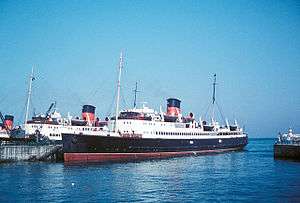
Beginning of the company
There had been various shipping companies serving the Isle of Man before the formation of this company in 1830, but such crossings were irregular and vessels used were unreliable. As a result the island could be cut off for weeks at a time.
The Manx people felt it was essential they should have their own dedicated service. A meeting was held in the island's capital Douglas in 1829, from which was formed a committee charged with finding out the cost of acquiring a Steam Packet.
On 30 June 1830, the forerunner of today's Isle of Man Steam Packet Company was born when the brand new vessel, Mona's Isle, built at a cost of £7,250, sailed from Douglas to Liverpool on its very first sailing. From the inauguration of the service until January 1832, the company was known as the Mona's Isle Company. For a brief period the company then traded as the Isle of Man United Steam Packet before assuming its present name in July 1832.
By the turn of the 20th Century, the Isle of Man Steam Packet Company was serving numerous ports in England, Wales, Scotland and Ireland.[2] Ports served included Liverpool, Silloth, Whitehaven, Holyhead, Ardrossan, Blackpool, Belfast and Dublin.
War service
Vessels and crews of the company were actively involved in both the First and Second World Wars. One vessel, King Orry, was attached to the British Grand Fleet and led the German High Seas Fleet into Scapa Flow in the Orkney Islands at the end of the First World War.[3] Another vessel, Viking, was converted to become a seaplane carrier, serving as HMS Vindex.
During the First World War, eleven out of a total fleet of fifteen Steam Packet ships were requisitioned by the Admiralty. Four of them were lost, three retained by the government and four returned to service. Ben-my-Chree and Manxman also served as aircraft/seaplane carriers.[3]
In the Second World War, ten of the fleet of sixteen ships were commandeered for active duty, four of which were lost. The Dunkirk evacuation was perhaps the company's finest hour, with Mona's Isle (IV) being the first to leave Dover and the first to complete the round trip during the evacuation. Eight company ships took part in this mission, rescuing a total of 24,699 British troops – one in fourteen of those evacuated from Dunkirk.
Sadly though, the Dunkirk evacuation also saw the company's blackest day, when three of the line's ships were lost.
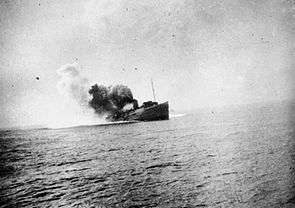
- Mona's Queen, mined off Dunkirk on 29 May;
- Fenella, sunk by air attack whilst berthed alongside the East Pier on 29 May;
- King Orry, sustained heavy damage following several air attacks on 29 May, and consequently sank off the beaches in the early hours of 30 May.[3]
The anchor from Mona's Queen (III) was raised as part of the 70th anniversary commemoration of Operation Dynamo at Dunkirk. It is sited at Kallow Point in Port St Mary as a memorial to the company's crew who took part in the war.[4]
Vehicle transport
Four side-loading RORO car ferries were introduced, beginning with Manx Maid in 1962, and followed by Ben-my-Chree (1966), Mona's Queen (1972) and Lady of Mann (1976). Mona's Isle (VI) was the Steam Packet Company's first stern loader in 1984-85.
The 1980s were tough times for the company, with declining passenger numbers. Strong competition from Manx Line's Manx Viking brought them close to collapse. In February 1985, they announced a merger with Sealink who had, by now, taken over Manx Line.[5] The main UK port switched from Liverpool to Heysham, thus ending (albeit temporarily as it turned out) an association lasting back to the company's origins.
2008 rebranding

In June 2007, a new CEO, Mark Woodward, was appointed to succeed Hamish Ross, promising to improve the company's services and to return to the classic livery and promote the Island's culture.
The first part of the rebranding was first exercised with the Sea Express 1 becoming Snaefell and SuperSeaCat Two becoming Viking, the latter having now been sold and operating for Atlantico Line as the Hellenic Wind.
The fleet received a brand new livery, replacing the old SeaCo livery. All fleet members received complete internal refits which reflected the company's new colours and the rebranding of the company's on board lounges. The terminals received new signage and new uniforms were made for crew and shore staff.
The company's first class lounge and members club were renamed, with 1st Lounge becoming the Premium Lounge and the Blue Riband Club became the Executive Club. The Quiet Lounge was also renamed, becoming the Niarbyl Reserved Lounge.
Today
In return for exclusive use of the linkspans at Douglas, the Steam Packet Company has made a guarantee of regular services to the Manx government. Ben-my-Chree and Manannan provide regular services to England and Ireland.
In addition to the regular routes, the company operates a small number of special day excursions to other destinations or round the Isle of Man during the summer months. Extra sailings are scheduled during times of high demand such as the TT period. The company also operates its own in-house travel agency, Steam Packet Holidays.
Ownership
In 1996, the Steam Packet Company became a wholly owned subsidiary of Sea Containers Ltd headed by James Sherwood, who had pioneered the fast-craft operation. In July 2003, the company was sold to Montagu Private Equity for £142 million (previously named HSBC Private Equity Ltd).
In 2005, the company was purchased by major Australian investment bank, Macquarie Bank for £225 million.[6] In April 2011, it was announced that the Steam Packet Company had new owners Banco Espírito Santo.[7]
Fleet
The company currently has a fleet of three vessels - a year-round conventional RO-PAX vessel, a chartered RO-RO freighter [8] and a fastcraft which operates on a seasonal basis.
| Picture | Name | Built | Commissioned | Route(s) | Tonnage | Port of Registry | Notes |
|---|---|---|---|---|---|---|---|
 |
MS Arrow |
|
|
|
|
|
On long term charter from Seatruck Ferries [9] |
 |
MS Ben-my-Chree [VI] |
|
|
Douglas - Birkenhead Douglas - Dublin |
|
|
Fleet flagship |
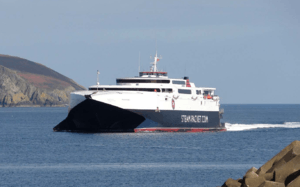 |
HSC Manannan |
|
|
Douglas - Belfast Douglas - Dublin |
|
|
|
Present day operations
The Steam Packet Company operates services between:
- Douglas - Heysham (Year-round service)
- Douglas - Liverpool (Seasonal service - March to November)
- Douglas - Birkenhead (Seasonal service - November to March)
- Douglas - Belfast (Seasonal service - April to September)
- Douglas - Dublin (Seasonal service - April to September & December)
Historic fleet
See also list of ships below
The company started with wooden paddle steamers, which soon gave way to the steel "screw" vessels. The "screw" vessels were superseded by turbine steamers, the first being the 1905 Viking. The company then replaced the passenger-only steamers with side-loading car ferries, the first diesel car ferry being the 1972 Mona's Queen (V). Fastcraft then became the next generation of vessels to operate for the company, the first being the SeaCat Isle of Man.
Pre-war steamers
The company built five steamers over ten years from 1927. They were the replacements for the various second-hand steamers that the company purchased to replace its First World War losses.
| Image | Ship | Built (Commissioned) | Route | Tonnage | Notes |
|---|---|---|---|---|---|
| Ben-my-Chree [IV] | (June 1927) | | | Scrapped at Ghent in 1965 | |
| Lady of Mann [I] | (June 1930) | | | Scrapped at Dalmuir in 1971 | |
 | Mona's Queen [III] | (? 1934) | | | Sunk at Dunkirk in 1940 |
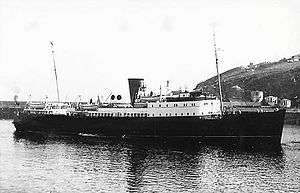 | Fenella | (? 1937) | Douglas — various | 2,376 GT | Sunk at Dunkirk in 1940 |
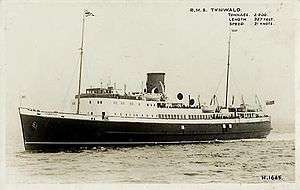 | Tynwald [IV] | (? 1937) | Douglas — various | 2,376 GT | Sunk off Bougie in 1942 |
The "Six Sisters"
A class of vessel derived from pre-war steamers Fenella and Tynwald affectionately known as the Six Sisters. These were all built by Cammell Laird in Birkenhead and were in service between 1946 and 1982. No two vessels were identical and all had their own (albeit minor) differences. The last vessel to be withdrawn was Manxman in 1982 - at the time it was the last vessel of its type in service in the United Kingdom. Despite preservation attempts the vessel was finally scrapped in 2012.
| Image | Ship | Built (Commissioned) | Route | Tonnage | Notes |
|---|---|---|---|---|---|
| King Orry [IV] | (January 1946) | | | Scrapped at Strood in 1979 | |
 | Mona's Queen [IV] | (June 1946) | | | Sold for further use as Fiesta Scrapped at Perama in 1981 |
| Tynwald [V] | (July 1947) | | | Scrapped at Aviles in 1975 | |
| Snaefell [V] | (July 1948) | | | Scrapped at Blyth in 1978 | |
| Mona's Isle [V] | (March 1951) | | | Scrapped in the Netherlands in 1980 | |
| Manxman [II] | (May 1955) | | | Scrapped at Sunderland in 2012 | |
Side-loading car ferries
The company developed a design of side-loading car ferries, with a spiral ramp at the stern. These could operate (as car ferries) from ports which were not equipped with linkspans. This design is unique to the Isle of Man Steam Packet Company still today.
| Image | Ship | Built (Commissioned) | Route | Tonnage | Notes |
|---|---|---|---|---|---|
| Manx Maid [II] | (May 1962) | | | Scrapped at Garston in 1986 | |
| Ben-my-Chree [V] | (May 1966) | | | Scrapped at Santander in 1989 | |
 | Mona's Queen [V] | (May 1972) | | | Sold for further use as Mary the Queen Scrapped at Alang in 2008 |
| Lady of Mann [II] | (June 1976) | | | Sold for further use as Panagia Soumela Scrapped at Aliaga in 2011 | |
RO-RO ferries
The company has operated a number of RO-RO passenger and freight ferries in its history, the pioneering vessel being the Peveril [IV] in 1981, in response to Manx Line's Manx Viking.
| Image | Ship | Built (Commissioned) | Route | Tonnage | Notes |
|---|---|---|---|---|---|
| Mona's Isle [VI] | (April 1985) | | | Sold for further use as Al Fahad Sunk off Jeddah in 2004 | |
| Tynwald [VI] | (October 1985) | | | Sold for further use as Lauro Express Scrapped at Alang in 2007 | |
| | King Orry [VI] | (February 1990) | | | Sold for further use as Moby Love Still in service |
| Peveril [IV] | (May 1981) | | | Sold for further use in 2000 Believed scrapped | |
 | Manx Viking | (1976) | | | Scrapped at Sault Ste. Marie, Canada |
| | Belard | (November 1993) | | | Sold for further use as Muirneag Still in service |
Fastcraft
The company has operated fastcraft since 1993.
| Ship | Built | Entered service | Route | Notes |
|---|---|---|---|---|
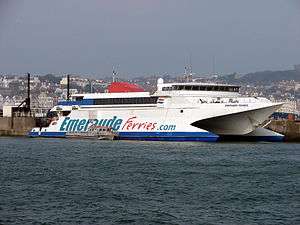 | Emeraude France | (March 2007) | Douglas — Liverpool/Belfast/Dublin | Chartered in 2007 Currently laid up at Tilbury |
| SeaCat Danmark | (May 1998) | Douglas — Liverpool/Belfast/Dublin | Chartered between 1998 and 2000 Now operating as Golden Blaze | |
 | SeaCat Rapide | (June 2004) | Douglas — various | Chartered in 2004 Now operating as Jaume II |
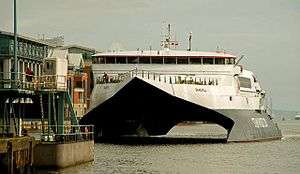 | Snaefell [VI] | (May 1994) | Douglas — Liverpool/Belfast/Dublin | Chartered to Sea Jets in Greece in 2011 Now operating as Master Jet |
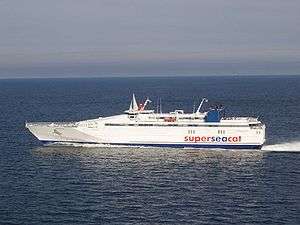 | SuperSeaCat Three | (2000) | Douglas — various | Now operating as Speedrunner III |
| | Viking [II] | (March 2003) | Douglas — Liverpool/Belfast/Dublin | Chartered 2003-8 Now operating as Hellenic Wind |
 | Manannan | (May 2009) | Douglas — Liverpool/Belfast/Dublin | Currently operating services from Douglas to Liverpool, Belfast and Dublin. |
Incidents
2007 Sea Express 1 accident
On 3 February 2007, Sea Express 1 (formerly SeaCat Isle of Man) collided with the cargo ship Alaska Rainbow in heavy fog in the River Mersey. None of the 294 passengers and crew was hurt, and the ferry was moored at Liverpool Pier Head while water was being pumped from the engine room, a number of cars remained on board. She was later towed to the Cammell Laird basin in Birkenhead where all cars remaining aboard were offloaded. On 14 March 2007, the Sea Express 1 was relaunched. In the meantime alternative service was provided by Ben-my-Chree to Birkenhead during the weekends. In December 2007, the vessel was renamed to become the sixth Snaefell.
2010 Ben-my-Chree accident
On 26 March 2010, while embarking passengers and loading vehicles at Heysham, England, the ro-ro passenger ferry Ben-My-Chree moved approximately eight metres along the quayside, causing serious damage to the passenger access structure. The foot-passenger walkway detached at both ends and collapsed onto the quayside, and the gangway detached from the vessel’s side shell door and was left hanging on a single rope. Fortunately, there were no injuries. Eight passengers were trapped in the gangway compartment of the shore structure and were later rescued by the local fire service.[11]
Competition
2010 competition with Mezeron
On 1 November 2010, it was reported on the Isle of Man Newspapers website, that the Steam Packet had lost two major freight customers to rival company Mezeron who had just set up a new freight service between Douglas and Liverpool a week or so earlier. In February 2011 Mezeron withdrew the service citing lack of growth in the market. Previously the Steam Packet Company had reported a loss of 15% of its total freight business to Mezeron.
Ellan Vannin Line
In early 2013 Sea Alliance announced plans for a new shipping company to serve the Isle of Man.[12] The company planned to use a 32-year-old vessel MV Cometa.[13] However the venture failed and nothing has been heard since.
Filmography
Steam Packet ships have been used in a number of films. Examples include Chariots of Fire where the team travel on a Steam Packet vessel with the Liver Building clearly visible. In the Barbra Streisand film, Yentl the ship carrying emigrants to the United States at the end of the film is the Manxman. The Ben-my-Chree [6] was used in 2004 as a double for an English Channel ferry in the film On a Clear Day. The Lady of Mann was also used in the 2004 film Mickybo and Me.
See also
References
- Most of the contents of this article have come from the company's own web site.
- Working the Sea, television documentary, BBC North West (2006) (Working the Sea feature - BBC Isle of Man website)
Notes
- ↑ http://investing.businessweek.com/research/stocks/private/snapshot.asp?privcapId=4941552
- ↑ http://www.manxradio.com/audiovault/History.mp3
- 1 2 3 "About Us". Isle of Man Steam Packet Company. Retrieved 10 February 2012.
- ↑ "Mona's Queen Anchor Memorial to be sited in Port St Mary". Isle of Man Steam Packet Company. 31 May 2011. Retrieved 10 February 2012.
- ↑ "The Merger". Mersey Ships. Retrieved 4 August 2013.
- ↑ "Macquarie Bank acquires Isle of Man Steam Packet Group". Macquarie Group Limited. 20 October 2005. Retrieved 11 February 2012.
- ↑ "New owners and corporate structure". Manx Radio. 8 April 2011. Retrieved 11 February 2012.
- ↑ "ISLE OF MAN STEAM PACKET COMPANY'S NEW FREIGHT VESSEL TO BEGIN OPERATIONS". Isle of Man Steam Packet Company. Retrieved 6 May 2014.
- ↑ http://www.steam-packet.com/aboutus/news/2013/Sep/SPC%20SECURES%20FREIGHTER%20ON%20LONG-TERM%20CHARTER
- ↑ "HSC INCAT 050 (1998)". Fakta om Fartyg. Archived from the original on 7 Sep 2012. Retrieved 2 May 2012.
- ↑ "Report into the 'Ben-My-Chree' incident at Heysham Port". Marine Accident Investigation Branch. December 2010. Retrieved 2010-12-29.
- ↑ http://www.iomtoday.co.im/news/isle-of-man-news/new-isle-of-man-shipping-line-to-hold-open-meeting-1-5866295
- ↑ http://www.iomtoday.co.im/news/isle-of-man-news/steam-packet-rival-issues-ultimatum-to-isle-of-man-government-1-6386883
9. ^ https://www.facebook.com/isleofmansteampacket 10. ^ http://www,twitter.com/iomsteampacket
Bibliography
- Basnett, Stan (2008). Ferries of the Isle of Man: 1945-Present Day (2nd ed.). Ramsey, Isle of Man: Ferry Publications. ISBN 9781906608033.
- Blackburn, Charles John; Leach, Frederic (1923). How the Manx Fleet helped in the Great War: The story of the Isle of Man Steam Packet Boats on service. Douglas, Isle of Man: L.G. Meyer. OCLC 557031509.
- Chappell, Connery (1980). Island Lifeline. Prescot, Merseyside, UK: T. Stephenson and Sons Ltd. ISBN 090131420X.
- Collard, Ian (2013). The Isle of Man Steam Packet through time. Stroud, Gloucestershire, UK: Amberley Publishing. ISBN 9781445614281.
- Cowsill, Miles; Hendy, John, eds. (2005). Steam Packet 175: 1830-2005: the official anniversary book of the Isle of Man Steam Packet Company. Ramsey, Isle of Man: Lily Publications. ISBN 1871947774.
- Cowsill, Miles; Basnett, Stan (2011). Steam Packet: the album. Ramsey, Isle of Man: Lily Publications. ISBN 9781906608477.
- Danielson, Richard (1996). So Strong and So Fair: Story of the Side-Loading Car Ferries of the Isle of Man Steam Packet Company and their people. Laxey, Isle of Man: Maritime Publications. ISBN 0951315595.
- Dearden, Steven; Hassell, Ken (1999). Ships of the Isle of Man Steam Packet Company. Ochiltree, Ayrshire, UK: Stenlake Publishing. ISBN 1840330783.
- Evans, Ron (December 1999). "The loss of the "Ellan Vannin"". Bulletin of the Liverpool Nautical Research Society. 43 (4): 1–11. OCLC 841925080.
- Evans, Ron (September 2000). "From short sea liner to blockade runner: a history of the Isle of Man Steam Packet Company's paddle steamer 'Douglas' (1) of 1858, as the Confederate blockade runner 'Margaret and Jessie', and as the Union Navy warship U.S.S. 'Gettysburg'". Bulletin of the Liverpool Nautical Research Society. 44 (2): 1–11. OCLC 841928207.
- Henry, Fred; O'Friel, F. B. (1977). Ships of the Isle of Man Steam Packet Co. Ltd. (4th ed.). Glasgow: Brown, Son & Ferguson. ISBN 0851742823.
- Howarth, Noel (1980). A Pictorial History of the Isle of Man Steam Packet Ships: 32 postcards. Birghton, UK: Motor-in-Mann Publications for the Isle of Man Steam Packet Company. OCLC 224505681.
- Moore, A.W. (2005) [1st. Pub. (1904) Manchester: R. Johnson and Sons, for the Isle of Man Steam Packet Co. Limited]. Historical account of the Isle of Man Steam Packet Co. Limited: 1830-1904. Ramsey, Isle of Man: Ferry Publications. OCLC 212430547.
- Shepherd, John (1994). The life and times of the Steam Packet. Kilgetty, Pembrokeshire, Wales: Ferry Publications. ISBN 1871947251.
- "Widow Lady" or "Little Alice" (1881). Little Alice; or a narrative relating to the origin of the Isle of Man Steam-Packet Company. Isle of Man: The Author. OCLC 223170020.
External links
- Official Website
- Marine Accident Investigation Branch: report into the Sea Express 1 & Alaska Rainbow collision (September 2007)
- Picture postcards of Steam Packet vessels from 1830 to the present day